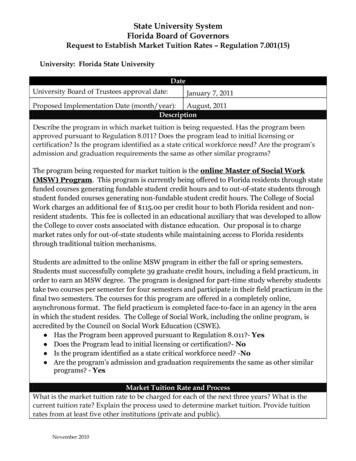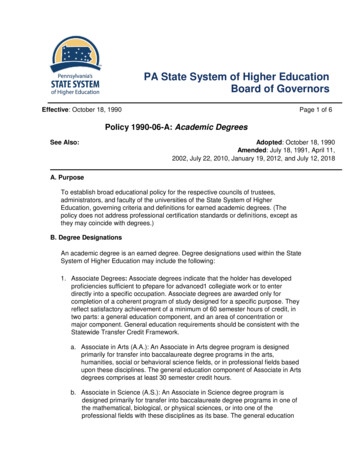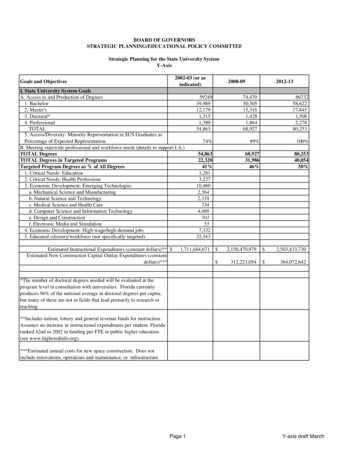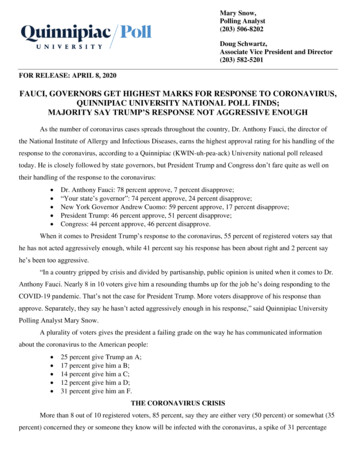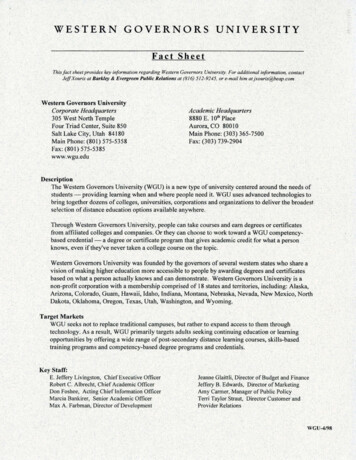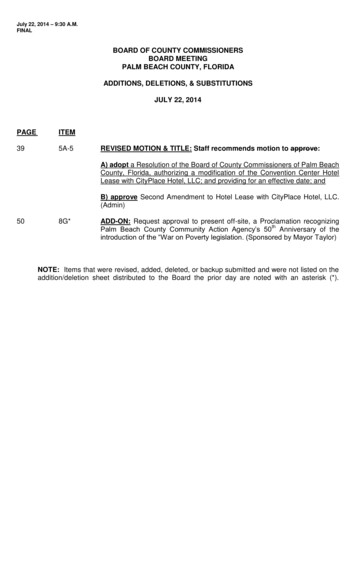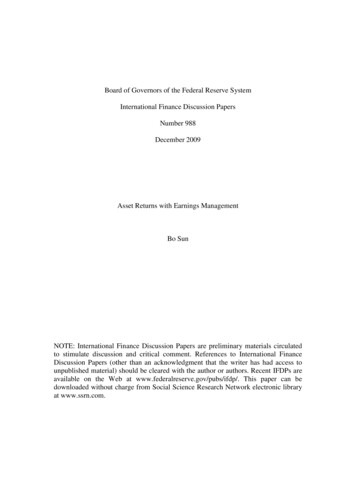
Transcription
Board of Governors of the Federal Reserve SystemInternational Finance Discussion PapersNumber 988December 2009Asset Returns with Earnings ManagementBo SunNOTE: International Finance Discussion Papers are preliminary materials circulatedto stimulate discussion and critical comment. References to International FinanceDiscussion Papers (other than an acknowledgment that the writer has had access tounpublished material) should be cleared with the author or authors. Recent IFDPs areavailable on the Web at www.federalreserve.gov/pubs/ifdp/. This paper can bedownloaded without charge from Social Science Research Network electronic libraryat www.ssrn.com.
Asset Returns with Earnings Management Bo Sun†Federal Reserve BoardAbstractThe paper investigates stock return dynamics in an environment where executiveshave an incentive to maximize their compensation by artificially inflating earnings. Aprincipal-agent model with financial reporting and managerial effort is embedded in aLucas asset-pricing model with periodic revelations of the firm’s underlying profitability. The return process generated from the model is consistent with a range of financialanomalies observed in the return data: volatility clustering, asymmetric volatility, andincreased idiosyncratic volatility. The calibration results further indicate that earningsmanagement by individual firms does not only deliver the observed features in theirown stocks, but can also be strong enough to generate market-wide patterns.Keywords: Earnings management, Stock returns, Financial anomalies, Volatility clustering, GARCH, Optimal contractJEL Classifications: E44, D82, D83, G12 I gratefully acknowledge Eric Young and Chris Otrok for their inspiration and support. A special debt ofgratitude is owed to Toshi Mukoyama for meticulous guidance and to Mark Carey for enormous help. I amalso greatly indebted to David Bowman, Antonio Falato, Pingyang Gao, Marvin Goodfriend, Jon Glover, RickGreen, Denis Gromb, Zhiguo He, Bob King, Pete Kyle, Nathan Larson, Richard Leftwich, Pierre Liang, YoheiOkawa, Michael Palumbo, Nagpurnanand R. Prabhala, Adriano Rampini, Steve Sharpe, Cathy Schrand,Abbie Smith, Xuan Tam, John Weinberg, Wei Xiong, and Stan Zin for their helpful comments. I sincerelythank the seminar participants at Boston University, Carnegie Mellon University, Cornell University, DardenSchool of Business, Federal Reserve Board of Governors, Federal Reserve Bank of Cleveland, Federal ReserveBank of Richmond, Georgetown University, INSEAD, Peking University, University of Chicago Booth Schoolof Business, University of Maryland, University of Virginia, Wharton School of Business, World Bank, andTsinghua University, for their helpful comments. In addition, I thank University of Virginia, John M. OlinFoundation, and Federal Reserve Board for financial support. The views expressed herein are the author’sand do not necessarily reflect the opinions of the Board of Governors of the Federal Reserve System.†Contact: Division of International Finance, Board of Governors of the Federal Reserve, Mail Stop 44,20th Street and Constitution Avenue, Washington, DC 20551. Bo.Sun@frb.gov. (202)452-2343.1
1IntroductionExecutives’ desire to use financial reports, especially bottom-line earnings, to pursue theirown financial interests gives rise to the phenomenon of earnings management, which is defined as intentional manipulation of reported earnings by knowingly choosing accountingmethods and estimates that do not accurately reflect the firm’s underlying fundamentals.The accounting irregularities at Enron and WorldCom that precipitated the stock marketdownturn of 2002 and the corporate scandals that triggered the financial meltdown in 2008,notably Freddie Mac and AIG,1 indicate that such behavior can engender significant economic consequences, especially in the financial markets. This paper explicitly examines theasset pricing implications of earnings management.This intentional manipulation of financial information must be reflected in the pricingof stocks, since it affects the inference of the investors who value the stock of a firm. Empirical studies (e.g., Turner et al. [2001], Wu [2002], and Palmrose et al. [2004]) suggestthat distorted information flow can cause adverse capital market reactions. In these studies, on average, stock returns fall by about 10% on the days around earnings restatementannouncements. Figure 1, reproduced from Wu [2002], documents how stock returns reactto restatements.2 However, due to the lack of theoretical guidance and difficulty of detecting earnings management with accuracy, comparatively little is known about the potentialsystematic impact of earnings management on stocks.The objective of the present study is to analyze the implications of earnings management1Morgan Stanley determined the accounting tactics, while legal, enabled Freddie Mac, and to a lesserextent Fannie Mae, to overstate the value of their reserves. Both companies also pushed inevitable lossesinto future by sharply curtailing their repurchase of soured mortgages out of the securitizations they haveguaranteed. “Fannie Mae and Freddie Mac were ‘playing games with their accounting’ to meet reserverequirements, prompting the government to seize control of the companies,” U.S. Senator Richard Shelby said(Bloomberg [September 9, 2008]). In the case of AIG, PricewaterhouseCoopers prompted an announcementabout the material accounting weaknesses related to the valuation of AIG’s derivatives holdings. Prosecutorsinsisted that five former executives from the American International Group deliberately mounted a fraudto manipulate its financial statements, after a string of AIG scandals early this decade.“Accounting flawsat American International Group significantly understated the insurance giant’s losses on complex financialinstruments linked to mortgages and corporate debt,” AIG said in an official public statement (The NewYork Times [February 12, 2008]).2I thank Min Wu for providing Figure 3 of Wu [2002], which is reproduced as Figure 1 in the currentpaper.2
Figure 1: Cumulative abnormal returns around restatements: day (-125, 125)0 0.05Returns 0.1 0.15 0.2 0.25 0.3 0.35 125 100 50050100125Days before and after restatements (announcement is made at day 0)This figure displays the mean of cumulative abnormal returns of restating firms from 1977 to 2001. Day 0is the restatement announcement date. Source: Wu [2002]for dynamic patterns of asset returns. In particular, this paper shows that earnings management is a possible explanation for a number of stylized financial facts, namely, volatilityclustering, asymmetric volatility, and increased idiosyncratic volatility. These results underscore why earnings management is of central importance in pricing financial assets, inunderstanding the risk implied by empirical financial anomalies, and in contemplating theongoing debate on regulations of financial markets and executive compensation.I conduct this exercise within a Lucas asset-pricing model that is standard in all aspects,except that the investors hire a manager to operate the firm and report the firm’s earnings. Inparticular, a principal-agent model with financial reporting and productive effort is embeddedin a simple variant of the Lucas asset-pricing model. The investors engage in a (single-period)contractual relationship with a newly hired manager in every period and pay the manager afraction of the reported earnings as compensation. The manager exerts an unobserved effortthat affects the production, and possibly has discretion over the quantity of apples reported3
to the investors. The reported earnings are paid to the investors as dividends. The keyfeature I focus on here is the manager’s ability to manipulate earnings reports. Earningsmanagement occurs in the model when the reported apple harvest (earnings) differs fromthe true amount.3There are periodic investigations concerning the underlying true earnings of the firm. Inthe final period of each revelation cycle, the uncertainty about true earnings is resolved, andthe investors bear monetary costs in the event that earnings management is detected.4 Theinvestors are assumed to be risk-neutral; thus the price of the firm in each period is givenby the discounted expected future dividends net of the labor wage and the financial lossassociated with earnings management.The return sequences generated from the model mimic a set of stylized facts in stock return data. First and foremost, the model returns exhibit volatility clustering. Because earnings management patterns vary with underlying true performance, certain levels of earningslead to higher frequency of restatements than others,5 creating larger swings in the returnsequence. Return volatility becomes state-dependent in the model. As the state (that is, actual earnings) exhibits persistence over time, return volatility is time-varying and persistent.In addition to the direct impact due to possible future manipulation, an indirect effect reflecting suspicion of previous misreporting amplifies the persistence in volatility. The possibilityof earnings management creates a range of reports that are associated with belief revisionand intense suspicion of manipulation. The anticipation of restatements increases uncertainty and hence volatility. The volatility persists as reported earnings persist. Although3The modeling technique presented here bears some similarities with Shorish and Spear [2005]. Thesimilarities and differences between their paper and this paper will be discussed later in this section.4This analysis does not make a distinction between earnings management and fraud. While the accountingchoices that explicitly violate Generally Accepted Accounting Principles (GAAP) clearly constitute bothearnings management and fraud, according to the SEC, systematic choices made within the boundaries ofGAAP can constitute earnings management as long as they are used to obscure the true performance of afirm and will lead to adverse consequences for the firm in the same way as fraud.Following this notion, there is no economic difference between fraud and earnings management in themodel: in both cases the reported number is different from the true amount, and such behavior hurts thefirm’s future prospects.5The notion of “restatements” in the paper does not necessarily imply actual restatement announcementsbut rather the broadly-defined adverse consequences of earnings management. The periodic revelations oftrue earnings in the model hence capture the negative consequences of earnings management that periodicallyshow up in returns and can be understood as reflecting the reversing nature of earnings management.4
the conditional heteroskedasticity observed in many financial markets has led to ARCH andGARCH models that are intensively used in analyzing stock returns, the underlying microeconomic motives are still not well understood. This paper presents the persistence inearnings management behavior as a likely source of the persistence in stock return volatility.The model data capture another stylized fact in the finance literature: asymmetric volatility in stock returns. The mechanism is also twofold. First, earnings management goeshand-in-hand with weak economic performance, due to stronger financial incentives to inflate earnings when the performance is weaker. Because current low earnings lead to morefrequent future earnings manipulation and resultant drastic consequences, low returns areassociated with high volatility in the subsequent periods. Second, earnings reports withincertain range are viewed as symptomatic of intentional misstatement. The inference of earnings management reduces the current price and increases the uncertainty over subsequentoutcomes, thereby intensifying asymmetric volatility.6 The existing literature on asymmetricvolatility falls into two categories: the leverage effect proposed by Black and Scholes [1973],Merton [1974], and Black [1976] and the volatility feedback effect put forward by French et al.[1987] and Campbell and Hentschel [1992]. However, Christie [1982] and Schwert [1989] findthat the leverage effect is too small to account for the asymmetry in volatility, and Campbelland Hentschel [1992] find that the volatility feedback effect normally has little impact onreturns. This paper shows that the asymmetric association of earnings management to trueearnings contributes to the observed asymmetric behavior in stock returns. The calibrationresults further suggest that this channel can be quantitatively important.Last but not least important, as earnings management becomes more likely in the model,asset returns exhibit greater volatility. The dramatic consequences of earnings managementgenerate active fluctuations in the return sequence and thus intensify return volatility. This6Following Shin [2003], Rogers et al. [2007] empirically document that strategic disclosure, defined as thereporting of good news and the withholding of bad news, provides an explanation for asymmetric returnvolatility. They find that asymmetric volatility is more pronounced in the return series of individual firms thatare more likely to disclose strategically as measured by their litigation risk incentives. Patterns in returnvolatility in market indices are also consistent with strategic disclosure as an explanation. As earningsmanagement represents strategic decisions in mandatory reporting, different from strategic disclosure withverifiable reports, I do not present their findings as direct empirical evidence for this model. However, theirpaper suggests that financial reporting decisions can matter in generating the observed patterns in stockreturns, in line with the prediction of the current model.5
work adds to a growing literature that studies individual stock return volatility. Campbellet al. [2001] document that the level of average stock return volatility increased considerablyfrom 1962 to 1997 in the United States. Furthermore, most of this increase is attributable toidiosyncratic stock return volatility as opposed to the volatility of the stock market indices.Rajgopal and Venkatachalam [2008] explore whether deteriorating financial reporting quality,as measured by earnings quality and dispersion in analyst forecasts of future earnings, canplausibly explain the increase in idiosyncratic volatility over the past four decades. Theirresults from cross-sectional and time-series regressions indicate a strong association betweenidiosyncratic return volatility and financial reporting quality. The current model replicatesthe positive relationship between the likelihood of earnings management and the volatilityof individual returns, and thus contributes to the theoretical explanations of the data.In this paper, the contracting system in a principal-agent model with financial reportingand moral hazard is first examined as a point of departure. This principal-agent model isdeveloped and analyzed in greater detail in Sun [2008]. The purpose of this step is to providethe underlying economic motive for earnings management in the model, to understand howmotives to induce managerial effort and to motivate truthful reports differentially affectthe optimal contract, and to identify how earnings management decisions vary with actualeconomic performance. This principal-agent model lays out a micro-foundation for assetpricing in that it generates a set of earnings reports that may or may not be systematicallybiased. This model of managerial reporting under moral hazard is built on Dye [1988]. Themessage space is limited to a single-dimensional signal while the privately informed agentreceives two dimensions of private information; therefore the Revelation Principle is notapplicable.77A recent paper by Crocker and Slemrod [2007] considers an alternative environment where the RevelationPrinciple can be applied. In solving the model, they assume a monotonically increasing reporting function;actual earnings can therefore be recovered by inverting the reporting function. In their setting, the principalknows the exact amount of actual earnings as a function of the report, while in the current model theprincipal faces uncertainty over whether earnings management occurs. The manager possesses a seconddimension of private information in this model, and hence the reporting function is no longer invertible. Asa model that constructs an explanation for earnings management, the current contract work can be viewedas complementary to theirs. As a microeconomic foundation for the investigation into asset pricing withearnings management, their model would generate prices that are fully revealing in the equilibrium; whereasthe investors in this model try to infer the true outcomes through Bayesian learning, but cannot perfectlysee through earnings management.6
In order to highlight the role that earnings management plays in price formulation, theprincipal-agent model with reporting choices is embedded into an otherwise standard Lucasasset-pricing model. In particular, by switching on and off the measure for earnings management in the model, I maintain the focus on earnings management and make the comparisonwith the standard asset-pricing model transparent. This modeling approach is related toShorish and Spear [2005], where the owner of the firm hires a manager to maximize thefirm’s value, and there is asymmetric information about the manager’s effort level betweenthe owner and the manager. Along this line of agency-based asset pricing, Gorton andHe [2006] show that when compensation depends on the firm’s market performance, stockprices are set to induce the optimal effort level. In contrast with these papers, the currentpaper focuses on earnings management incentive in the contractual relationship and priceformulation by assuming additional asymmetric information regarding output realizations.This analysis also relates to the literature on asset pricing under asymmetric information,such as Detemple [1986], Wang [1993], and Cecchetti et al. [2000]. In particular, Wang[1993] presents a dynamic asset-pricing model in which the investors can be either informedor uninformed: the informed investors know the future dividend growth rate, while theuninformed investors do not. He finds that the existence of uninformed investors can lead torisk premia much higher than those under symmetric and perfect information. Distinguishedfrom previous studies that examine the impact of information asymmetry and heterogeneousbeliefs among investors, the study reported in this paper analyzes information asymmetrybetween corporate executives and outside investors as a whole.There have not been many theoretical studies that examine the economic impact of earnings management. Fischer and Verrecchia [2000] is an early and notable exception. Theyshow that more bias in the report reduces the correlation between share price and reportedearnings, and they also study how the cost to the manager of biasing the report and themarket’s uncertainty about the manager’s objective affect the slope and the intercept termin a regression of market price on earnings reports. Subsequently, Guttman et al. [2006]use a signaling model similar to Fischer and Verrecchia [2000] to explain the discontinuity observed in the distribution of earnings reports. While these papers do not model thecontractual relationship between shareholders and the manager, Kwon and Yeo [2008] con7
sider a single-period model where the principal takes into account how compensation affectsproductive effort and market expectations when designing the optimal contract. In theirpaper, a rational market can simply recalibrate or discount the reported performance whenthe manager overstates earnings, and correctly guess the true performance. They show thatsuch rational market discounting leads to less productive effort by the manager and lessperformance pay by the principal. In contrast with the studies presented in these papers,the current study considers stock returns un
Board of Governors of the Federal Reserve System International Finance Discussion Papers Number 988 December 2009 Asset Returns with Earnings Management Bo Sun . NOTE: International Finance Discussion Papers are preliminary materials irculated c to stimulate discussion

